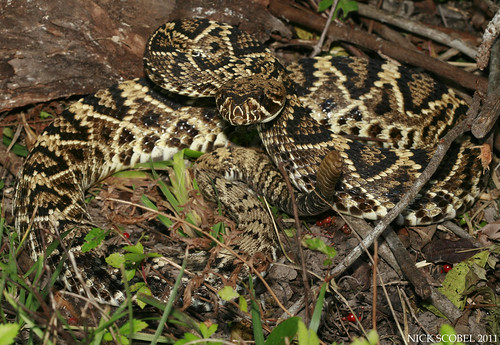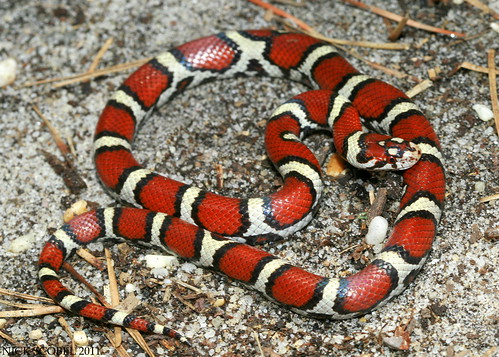Northern Pine Snake - Pituophis melanoleucus melanoleucus
Last week, there was a poaching event involving a Northern Pine Snake nest in New Jersey pine barrens and a nesting female may also have been collected in the process. One has to wonder, with all the bloodlines of NJ locality pines which are available from a captive breeding environment, why would someone collect out a pine snake from the wild? For me, I will never understand anyone's want or need to collect any species of snake from the field. Granted, I always brought home garter snakes when I was a kid, but even then I released them the next day. I guess I don't understand why hobbyists just can't enjoy a snake in the field and not feel the need to take something home with them. A Black Pine Snake (Pituophis melanoleucus lodingi) was recently found in extreme NW Florida in the pandhandle, where the Florida Pine Snake (Pituophis melanoleucus mugitus) likely intergrades with the Black Pine Snake. In either case, it is a very unique animal to find in Florida. After seeing a photo of this gorgeous snake posted on Facebook, I asked the guy who posted the photo whether or not the snake was collected and sure enough it was. Why? So you can appreciate the snake only by taking it home? So you can breed it and sell its offspring for money? To me, there is no difference between collecting animals to make money of them and clearing habitat for a new housing development, either way the ecology of the area takes a hit. A hobbyist may make an excuse that, "I only took one or two snakes." For every one collector who bags a single snake, there are a dozen more who do the exact same thing and make the exact same excuse.
Eastern Diamondback Rattlesnake - Crotalus adamanteus
Recently there has been a big push by several conservation organizations for the USFWS to list the Eastern Diamondback as an endangered species. The USFWS is currently conducting an internal review to decide whether or not the species would be listed. Recently, another individual posted a photo of a diamondback with its head cut off and rattle missing with a caption stating, "Federal protection will not stop this sort of thing from occuring in rural Florida." I was really put off by a comment another Florida resident and well known EDB collector and breeder made. It essentially re-iterated that federal protection will not stop senseless killings of EDBs in rural areas and that the only thing federal protection would do is stop private keepers from propagating them. That is an incredibly ignorant stance in my opinion. One of the largest problems facing diamondbacks is habitat loss, in fact more than 3/4 of its coastal plain pine forest has been developed. Diamondback populations need fairly large expanses of contiguous habitat to propagate and most of these areas that are left are highly fragmented by roads and urban sprawl. Senseless killings, road mortality, and habitat loss have contributed to its decline. Federal protection would help ensure that its remaining habitat remains intact and that anyone who is caught killing or collecting a diamondback would receive heavy fines. This would not completely eliminate senseless killing of EDBs, but it would cetainly help reduce them by making examples of several people. The main reason that the individual I've mentioned is so against federal protection is that he would no longer be able to keep and breed diamondbacks, which I'm sure helps supplement his income. It's disgusting to me that people would denounce listing a species which is in such dire need of federal protection because it would "prevent private keepers from propagating them." There's a lot more involved with the future of the EDB than that, sorry.
Coastal Plains Milk Snake - Lampropeltis triangulum "temporalis"
There has also been some poaching involving Coastal Plains Milk Snakes in the New Jersey pine barrens, particularly with an individual from New York. Coastals are a unique and beautifully marked snake which are found from southern New Jersey along the coast to North Carolina. It is unfortunate that people collect these animals, particularly in a region where it is illegal to do so. If you see any suspicious activity involving collection of a snake, particularly with protected species, call your local Conservation Officer and get plates or descriptions of vehicles if you can. I don't want to bash everything about hobbyists though, so let me be clear. Many of these people use snakes as tools for public outreach to help educate people on the importance of snakes in the natural environment, so that in itself is good. It is just that I have seen more unethical behavior out of collectors than I have seen ethical behavior, just my $0.02 on the situation.




I could not have made a better case against collection myself. Thank you for doing this, Nick. The more people that do, the more collectors will be denounced by the general herper population at large. There is ZERO reason why people should collect wild species, unless they are critically-endangered and are being bred for conservation reasons. Even then, it should only be done by professionals.
ReplyDeleteI agree, Nick. I think all of my kids will grow up to respect this too because I'm constantly talking about not wanting to see birds, snakes, turtles, amphibians in cages or aquaria. I'm not even a fan of bugs being kept in an enclosed space. They are cool to see, but let them do what they are supposed to be doing. That's another reason to just get outside as much as possible.
ReplyDeleteCindi
Nick,
ReplyDeleteIt's a delicate issue, but your views and mine are almost completely in line. There is something to be said for the knowledge that can be gained by keeping and breeding snakes and other herps in captivity. In many cases, this kind of information could not be obtained from wild animals. Unfortunately, the days when that could be done responsibly by collecting animals from the wild are gone, and we all need to start thinking a little harder about where we get the animals we use for scientific experiments, enjoyment, and other purposes. You're right on with your statement that it's the cumulative impact of the ever-increasing number of collectors that causes ecological damage, rather than the individual actions of any one, no matter how prolific. It's a classic tragedy of the commons. My personal feelings toward seeing a snake in its environment vs seeing it in an aquarium are the same as yours, and they underscore the need for conservation and protection of whole, intact natural environments, rather than just individual species. Ecologically, an individual species is useless without its environment, and captive individuals of a species might as well be extinct for all the ecological impact they have. I find the commercialization of wildlife as unpalatable as you, because it externalizes the real value of intact ecosystems.
Good article.
Thanks for reading the article guys, I hope you enjoyed it. All I wanted to do with this post was to stimulate discussion on this issue and to validate that I wasn't the only person that felt this way. I know some good people on both sides of this issue and didn't want to completely discredit herpetoculture. I would say that the majority of the people involved with the herp industry are ethical, but there a lot of people and practices involved with the industry which are not ethical. And there seems to be an increasing trend in those who are not on the ethical side of things. This issue is one that faces not just pine snakes or the state of New Jersey, but many herp populations throughout the country which are desirable to collectors.
ReplyDelete